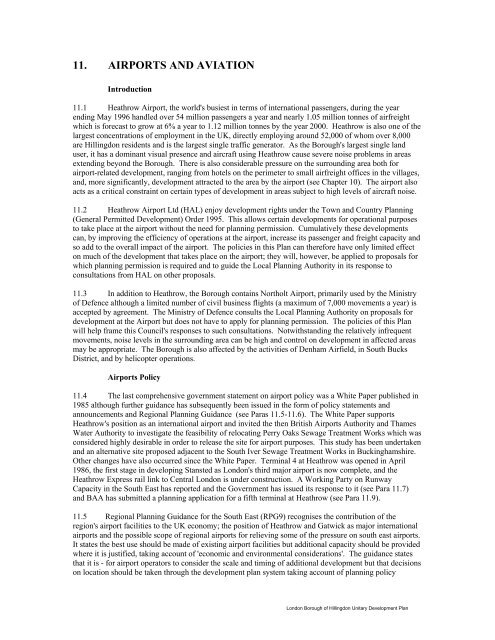HILLINGDON UNITARY DEVELOPMENT PLAN - London Borough ...
HILLINGDON UNITARY DEVELOPMENT PLAN - London Borough ...
HILLINGDON UNITARY DEVELOPMENT PLAN - London Borough ...
Create successful ePaper yourself
Turn your PDF publications into a flip-book with our unique Google optimized e-Paper software.
11. AIRPORTS AND AVIATION<br />
Introduction<br />
11.1 Heathrow Airport, the world's busiest in terms of international passengers, during the year<br />
ending May 1996 handled over 54 million passengers a year and nearly 1.05 million tonnes of airfreight<br />
which is forecast to grow at 6% a year to 1.12 million tonnes by the year 2000. Heathrow is also one of the<br />
largest concentrations of employment in the UK, directly employing around 52,000 of whom over 8,000<br />
are Hillingdon residents and is the largest single traffic generator. As the <strong>Borough</strong>'s largest single land<br />
user, it has a dominant visual presence and aircraft using Heathrow cause severe noise problems in areas<br />
extending beyond the <strong>Borough</strong>. There is also considerable pressure on the surrounding area both for<br />
airport-related development, ranging from hotels on the perimeter to small airfreight offices in the villages,<br />
and, more significantly, development attracted to the area by the airport (see Chapter 10). The airport also<br />
acts as a critical constraint on certain types of development in areas subject to high levels of aircraft noise.<br />
11.2 Heathrow Airport Ltd (HAL) enjoy development rights under the Town and Country Planning<br />
(General Permitted Development) Order 1995. This allows certain developments for operational purposes<br />
to take place at the airport without the need for planning permission. Cumulatively these developments<br />
can, by improving the efficiency of operations at the airport, increase its passenger and freight capacity and<br />
so add to the overall impact of the airport. The policies in this Plan can therefore have only limited effect<br />
on much of the development that takes place on the airport; they will, however, be applied to proposals for<br />
which planning permission is required and to guide the Local Planning Authority in its response to<br />
consultations from HAL on other proposals.<br />
11.3 In addition to Heathrow, the <strong>Borough</strong> contains Northolt Airport, primarily used by the Ministry<br />
of Defence although a limited number of civil business flights (a maximum of 7,000 movements a year) is<br />
accepted by agreement. The Ministry of Defence consults the Local Planning Authority on proposals for<br />
development at the Airport but does not have to apply for planning permission. The policies of this Plan<br />
will help frame this Council's responses to such consultations. Notwithstanding the relatively infrequent<br />
movements, noise levels in the surrounding area can be high and control on development in affected areas<br />
may be appropriate. The <strong>Borough</strong> is also affected by the activities of Denham Airfield, in South Bucks<br />
District, and by helicopter operations.<br />
Airports Policy<br />
11.4 The last comprehensive government statement on airport policy was a White Paper published in<br />
1985 although further guidance has subsequently been issued in the form of policy statements and<br />
announcements and Regional Planning Guidance (see Paras 11.5-11.6). The White Paper supports<br />
Heathrow's position as an international airport and invited the then British Airports Authority and Thames<br />
Water Authority to investigate the feasibility of relocating Perry Oaks Sewage Treatment Works which was<br />
considered highly desirable in order to release the site for airport purposes. This study has been undertaken<br />
and an alternative site proposed adjacent to the South Iver Sewage Treatment Works in Buckinghamshire.<br />
Other changes have also occurred since the White Paper. Terminal 4 at Heathrow was opened in April<br />
1986, the first stage in developing Stansted as <strong>London</strong>'s third major airport is now complete, and the<br />
Heathrow Express rail link to Central <strong>London</strong> is under construction. A Working Party on Runway<br />
Capacity in the South East has reported and the Government has issued its response to it (see Para 11.7)<br />
and BAA has submitted a planning application for a fifth terminal at Heathrow (see Para 11.9).<br />
11.5 Regional Planning Guidance for the South East (RPG9) recognises the contribution of the<br />
region's airport facilities to the UK economy; the position of Heathrow and Gatwick as major international<br />
airports and the possible scope of regional airports for relieving some of the pressure on south east airports.<br />
It states the best use should be made of existing airport facilities but additional capacity should be provided<br />
where it is justified, taking account of 'economic and environmental considerations'. The guidance states<br />
that it is - for airport operators to consider the scale and timing of additional development but that decisions<br />
on location should be taken through the development plan system taking account of planning policy<br />
<strong>London</strong> <strong>Borough</strong> of Hillingdon Unitary Development Plan
















